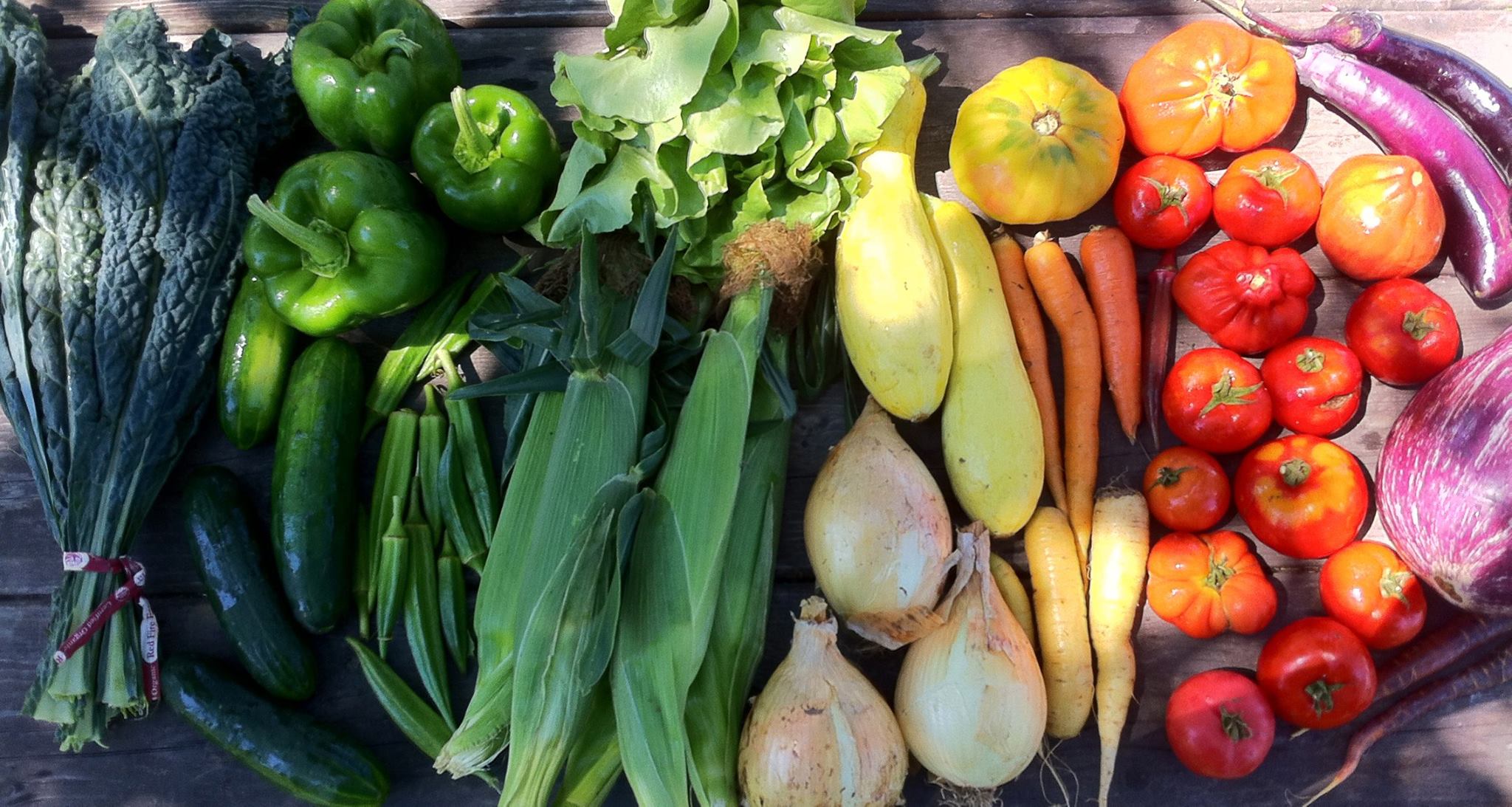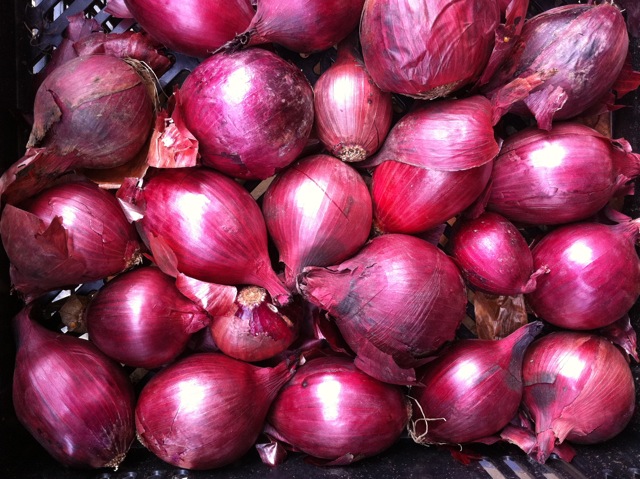
Fennel
Cooking Tips
We enjoy fennel for a limited time in CSA shares and at the farmers market. Great fresh chopped up in salads or braised or broiled, the fennel bulb is very versatile and its licorice-flavor is sweet and refreshing. When preparing, trim the bottom part right where it attached to the root, as it is tougher.
All the fronds are edible as well: as garnish, in salad, as an ingredient to soup or a saute. Chop them up for use in dressings, salads, and sauces, or blend into a quick pesto with some cheese, nuts, and maybe another leafy green. You can chop and freeze the fronds for making tea later on. Have you guessed yet that it’s in the same family as dill? Perhaps you didn’t guess that it’s also in the family with carrots and parsnips… umbelliferae.
Fennel is high in Vitamin C, folate, manganese and potassium.

Endive and Escarole
The Basics
Folks in Europe buy endive like we do lettuce. We don’t grow the pointy pod-shaped Belgian endive, it’s the big green curly head of endive that we have. This plant comes from the chicory family and shares the characteristic touch of bitter flavor that makes it a great pairing with sweeter salad dressings, roasted beets, candied pecans. Incorporate some endive into each salad you make for more flavor.
Endive is high in folate and vitamins A and K. It’s also great wilted or sauteed in any dish you’re making.
Escarole is very similar in flavor and use, but has broader leaves.
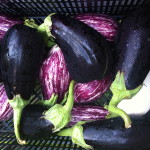
Eggplant
The Basics
We grow a wide variety of colorful eggplants, everything from your classic dark purple globes to Italian heirloom varieties to delicate-skinned Orient Express.
Cooking Tips
Salting eggplant slices will draw out moisture to leave a firmer texture, and will also reduce bitterness in the seeds if you have a more mature eggplant.
Roast skinny Asian eggplants and glaze with miso for a quick and satisfying side dish.
Grilled eggplant on a sandwich with rustic bread or on top of homemade pizza can’t be beat!
Edamame
The Basics
If you’ve never had young soybeans, these will be a nice surprise! Since all the beans ripen at once, we can pick the whole plant and give you the fun job of removing the beans from the stem. Don’t be shy about the job–the beans have a tough shell and can take any pulling or snapping needed to get them off the plant. These are not the same kinds of soybeans that are grown for animal feed or soymilk, they are special varieties for eating at the tender green stage.
Cooking Tips
Edamame are also very easy to prepare for a tasty snack. You don’t eat the pod, just the beans inside. The easiest thing to do is boil them until beans are tender and pop them direct from the pod into your mouth. You can also cook them and shell them for addition to salads or other dishes.
Once removed from the pods, edamame beans are easy to freeze. Throw them in a bag and put in the freezer until winter months call for a tasty addition to soups or grain salads.

Dill
The Basics
Dill has such a refreshing flavor in the summer time. Dill is a member of the Apiaceae family, which is related to spices like caraway, cumin, and coriander, as well as veggies like carrots, parsnips, fennel, and celery.
Cooking Tips
Its delicate leafy fronds make an appealing splash of green with potatoes or in dressings, and of course a with a classic dill pickle.
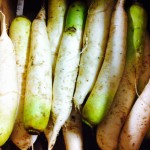
Daikon Radish
Daikon, highly popular in Japan, is a long white radish, milder in flavor than the other fall and winter radishes we grow. It’s beautiful grated like snow over the top of a salad, or on a sandwich. They are great in miso soup and noodle soups- nice sliced and added to miso soup right near the end of cooking time. Thin slices of daikon make a good cracker to go with cheese or hummus. You can also make lacto-fermented daikon pickle, use them in kimchi, or try in a sweet vinegar pickle.
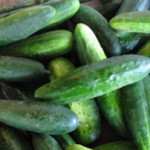
Cucumbers
The Basics
We grow two kinds of cucumbers, pickling and slicing. Pickling varieties have skins that are good at absorbing flavor, and the fruits ripen to smaller sizes than your typical slicing cucumber. You can cut up and eat pickling cucumbers fresh just the same as you would slicing cucumbers; they both taste great.
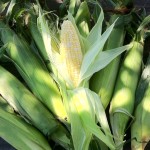
Corn
The Basics
Sweet corn is one of the joys of summer. It is best super fresh as flavor and sweetness wane somewhat quickly after harvest. We are very picky with our corn and get frequent harvests for our farmstands, and pick to order for the CSA. Improvements by crop breeders over the last few years have made newer varieties of sweet corn stay sweeter longer after harvest (not genetic modification, just regular crop breeding). We don’t grow or buy in any genetically modified sweet corn.
Some of crop will occasionally have corn earworms. The worms aren’t bad for you in any way. If you get corn with a worm in it, you can just chop off that part and the rest of the ear will be good. Please do not open ears to check for worms or ripeness, as it damages the ears for other people! Corn is delicious and the worms probably pick the sweetest ears to taste themselves.
We recommend leaving the husk on the cob until right before you’re going to prepare it, because the kernels easily dry out without their protective husk.
Cooking Tips
To steam corn, place the corn in a big pot, cover with cool water, and leave the lid on. When the water comes to a boil, the corn is done! Undercooking sweet corn isn’t a big problem, because it’s just as tasty raw. It’s best not to salt the water in the pot, because it can make the corn tough.
To roast ears of corn on the grill, keep their husks on and dunk the ears in water, drain, then place on a rack above your coals. Roast and turn until the outside husks are browned (or blackened as some like it!). Sometimes it cooks through and browns the surface of the kernels in spots with a wonderful caramelizing effect. You can also cut off the tip of each ear and pull out some of the silk before roasting if you’d like.
Did you know you can eat corn raw? That’s how we check if it’s ripe in the field. You can cut it off the cob and toss in salad or mix into fresh salsa.
If you get a bunch of fresh corn, you can cook it all right away to preserve the sweetness, and then use in various dishes later on. Grill previously steamed corn to warm and get some grill flavor. Or cut from the cob for use in salads. You can freeze it after cooking too, on the cob or off. Cobs can be boiled with some herbs and onion to make tasty soup stocks for corn chowder or other summer soups.

Collards
A member of the cabbage family, collard greens have a long history in the southern states, yet their popularity has grown recently throughout the nation. They store great in the fridge (a few days longer than more vulnerable greens like lettuce). Packed full of vitamins and minerals, these greens can be used anywhere you’d use spinach, kale or any other dark leafy green.
They’re also delicious raw in wraps, using the collard green like a tortilla.
In this photo, the collards are in the upper left-hand corner.

Cilantro
The Basics
Fresh cilantro, which we grow during most of the year, is a treat! Its flavorful green leaves have an aromatic citrus taste that is a classic component of many salsas. You’ll also see cilantro in many Asian and Indian dishes.
Cooking Tips
Cilantro is best while very fresh– when buying, be sure that it is very aromatic. Be sure to use the stems, because they hold the most flavor. Cilantro does not keep its flavor when dried, so this is an herb to freeze if you have extra and want to preserve the taste.




